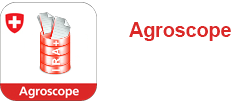Schouten C. M., Vogelgsang S., Six J., Schöneberg T.
Environmental impact of common bean production: A study using on-farm experiments.
In: Food Day 2025. 29 October, Zürich (CH). 2025.
Liechti C., Mack G., Walther B., Ammann J.
Transforming plant-based milk alternatives for better health.
In: 39th EFFoST International Conference. 17 November, Porto (PT). 2025.
Liechti C., Mack G., O'Sullivan K., Beretta C., Tiefenbeck V., Ammann J.
Cultural differences in food waste: Insights from a national Swiss food waste diary study.
In: 39th EFFoST International Conference. 17 November, Porto (PT). 2025.
Rubeaud C., Kay S., Walder F., Six J.
Assessing the potential of agroforestry systems to improve soil health and climate resilience.
In: PhD Symposium - Institute of Agricultural Sciences ETHZ. 7. November, Einsideln (CH). 2025.
La Forgia D., Wilhelm M.
SOPRA se refait une beauté (intérieure) : Développement du modèle et monitoring à l'aide de kairomones et de pièges à lumière UV.
In: Pflanzenschutztagung Obstbau 2025. 21 novembre, Berne (CH). 2025.
Manzocchi E., Viry L., Eggerschwiler L., Hayoz B., Schlegel P., Dohme-Meier F.
Affouragement en vert de sorgho multi-coupes : Effets sur l'ingestion, la production, la composition et l'aptitude à la coagulation du lait.
In: Journée vaches laitières. 21 novembre, Hrsg. Grangeneuve et Agroscope, Grangeneuve (CH). 2025.
Botzas-Coluni J., Manzocchi E., Terranova M., Manoukians A., Ledermann P., Probo M., Mariotte P.
Ertrag, Nährwerte und Verdaulichkeit der Blätter von sechs Futterbaumarten.
In: Journée vaches laitières 2025. 21. November, Grangreneuve (CH). 2025.
weitere Sprachen:
Liechti C., Mack G., Walther B., Ammann J.
Nährwertprofil und Labels von Milchersatzprodukten.
In: Austausch Agroscope und Konsumentenorganisationen Schweiz. 20. November, Liebefeld (CH). 2025.
Mariotte P.
Climate-smart agricultural systems for forage production.
In: ReClean Project - Stakeholder Workshop. 26. November, Hrsg. EPFL-PSI-ETHZ-EAWAG, Bern (CH). 2025.
Latsch A. J., Zorn A.
Ressourcenprojekt PFLOPF: Ökologische Aspekte, Praxisakzeptanz, Kosten und Nutzen der Technologiemassnahmen im Obst- und Rebbau.
In: Abschlussworkshop PFLOPF Obst-/Rebbau. 24. November, Arenenberg (CH). 2025.
Schori F.
Neue Fütterungsempfehlungen für Milchvieh, Mast- und Aufzuchtrinder: Wo stehen wir, und wo wollen wir hin?
In: SuisseTier 2025. 21. November, Luzern (CH). 2025.
Köstel J.
The need for and challenges in standardizing soil physical analysis.
In: 9th Meeting of the Global Soil Laboratory Network. 12 November, Hrsg. FAO, Online. 2025.
Gabioud Rebeaud S.
Innovative Nacherntemethoden zur Kontrolle parasitärer Lagerkrankheiten bei Kernobst: INNOSTOCK-Projekt.
In: Pflanzenschutztagung Obstbau. 21. November, Bern (CH). 2025.
Meyer M.
Resilienz der Alpwirtschaft und die Rolle der Direktzahlungen.
In: Älplertreffen Witzenhausen 2025. 23. November, Witzenhausen (CH). 2025.
Gouerou M., Visse-Mansiaux M., Brostaux Y., Deleu C., Val F., Leport L., Dupuis B.
Effect of climate change on potato yield and starch content.
Field Crops Research, 330, 2025, Artikel 109951.
Schöneberg T.
Der Duft des Pflanzenschutzes.
Gmüesblatt, (5), 2025, 3.
Ding T., Guo Z., Köstel J., Li J., Liu J., Peng X.
Organic fertilization under conservation tillage enhances biopore formation and particulate organic matter accumulation via fraction-specific pore relationships in a Vertisol.
Geoderma, 463, 2025, Artikel 117602.
Guyer A., Sauer C.
Die Schweiz rüstet sich für den Ernstfall: Die Baumwollkapseleule (Helicoverpa armigera) ist ein invasiver Schädling. Sie besitzt wegen ihres breiten Wirtspflanzenspektrums ein grosses Schadpotenzial.
Gemüse (D), 8, 2025, 28-30.
Anken T., Baumgartner S., Bérard J., Blaser S., Bragazza L., Carlen C., Dohme-Meier F., El Benni N., Fabian Y., Flury C. M., Garland G., Gilgen A., Guillaume T., Häfner F., Herrera Mourente J. M. und weitere
Umweltwirkung von Landwirtschaftsbetrieben mit Hilfe von Indikatoren messen und optimieren: Synthesebericht des Agroscope Forschungsprogramms Indicate.
Agroscope Science, 223, 2025, 1-128.
Sauer C., Debonneville C.
Ergebnisse des Zikadenmonitorings im Gemüsebau 2025.
Gemüsebau Info, 30, 2025, 1-2.
weitere Sprachen:






